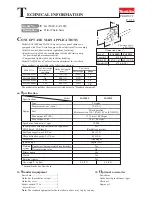
- 11 -
TYPES OF BLADES
Bandsaw blades are available in specific sizes, or in 100 feet coils. They are made from
several different metals:
1. Carbon Steel Blade: which are widely used because of their general adaptability for all
types of work and the low cost. They are excellent for cutting nonferrous metals and
plastics.
2. High-Speed Steel Blade: which resist heat generated in cutting to far greater extent than
carbon steel blades. They are best suited for cutting ferrous metals.
3. Alloy Steel Blade: which are tougher and more wear resistant than either of the above.
They will cut faster and longer than blades of carbon or high-speed steel.
4. Carbide-Tipped Blade: which are best used for cutting unusual materials such as
uranium, titanium, and beryllium. These metals are difficult to cut with other types of
blades.
TOOTH SHAPES
The regular or standard tooth is preferred for all ferrous metals and general-purpose cutting.
The skip-tooth blade has widely spaced teeth to provide the added chip clearance needed
for cutting softer nonferrous materials. The hook, or saber tooth blades has a 10°undercut
which permits better feed and chip removal, it is best for the harder nonferrous alloys
.
SET TYPES
Regular or rake set is generally furnished on saws that have 2 to 24 teeth per inch. These
blades have one tooth set to left, one to right, and one unset tooth called a rake. This set is
used when material is to be contour cut. Wavy set is furnished on saws that have 8 to 32
teeth per inch. This set has groups of teeth bent alternately to left and right, which greatly
reduce the strain on individual teeth. Saws with wavy set are used where tooth breakage is
a problem, such as in cutting thin stock or where a variety of work is cut without changing
blades
.
Of the three common set patterns, only raker and wave are now used in metalworking.
Always use rake set except:
For work of varying cross
section use wave set.
When one blade must be
used for a range of material
sizes use wave set













































